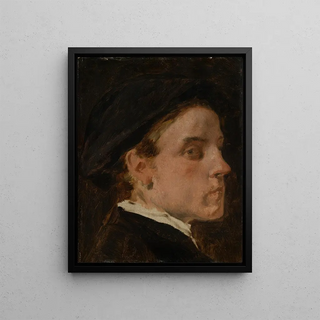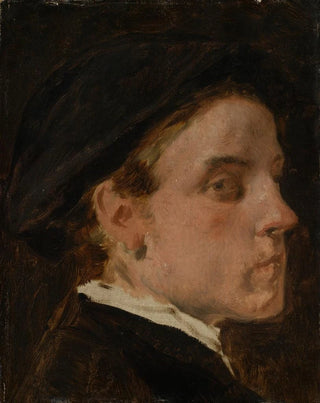Art print | Portrait study by painter Wilhelm Trübner - Hans Canon


View from behind

Frame (optional)
In the rich and complex universe of art history, certain works stand out for their ability to capture not only the appearance of a subject but also its essence. The art print Étude de portrait du peintre Wilhelm Trübner - Hans Canon is a perfect example. This painting, created by Hans Canon, immerses us in the intimacy of the creator, revealing the subtleties of his artistic expression. Through this portrait, the viewer is invited to explore the depths of the human psyche while discovering the refined techniques that characterize Canon's style. This iconic work bears witness to an era when the portrait was much more than a simple representation; it was a window into the soul.
Style and uniqueness of the work
Hans Canon's style in this art print is marked by impressive technical mastery, combining realism and psychological subtlety. The features of Wilhelm Trübner's face are rendered with a precision that borders on perfection, with each shadow and light playing a crucial role in the composition. The colors, both rich and delicate, create an almost tangible atmosphere, allowing the viewer to feel the emotion the artist aimed to convey. Canon excels in the art of texture, whether through the subject's clothing or the background surrounding him. This work is also characterized by a depth of field that draws the eye and guides the gaze toward the painter's face, thus emphasizing the importance of the individual within the frame of the work. In sum, this study stands out for its authenticity and its ability to establish a strong emotional connection between the subject and the observer.
The artist and his influence
Hans Canon, an artist of Austrian origin, managed to establish himself on the 19th-century art scene thanks to his undeniable talent and unique vision. Trained in the most influential artistic circles of his time, he mingled with major figures who shaped modern art. His approach to the portrait, which combines academic rigor and personal sensitivity, paved the way for new ways of thinking about the depicted subject. Canon was able to capture not only the physical appearance of his contemporaries but also their character and essence, a

Matte finish

View from behind

Frame (optional)
In the rich and complex universe of art history, certain works stand out for their ability to capture not only the appearance of a subject but also its essence. The art print Étude de portrait du peintre Wilhelm Trübner - Hans Canon is a perfect example. This painting, created by Hans Canon, immerses us in the intimacy of the creator, revealing the subtleties of his artistic expression. Through this portrait, the viewer is invited to explore the depths of the human psyche while discovering the refined techniques that characterize Canon's style. This iconic work bears witness to an era when the portrait was much more than a simple representation; it was a window into the soul.
Style and uniqueness of the work
Hans Canon's style in this art print is marked by impressive technical mastery, combining realism and psychological subtlety. The features of Wilhelm Trübner's face are rendered with a precision that borders on perfection, with each shadow and light playing a crucial role in the composition. The colors, both rich and delicate, create an almost tangible atmosphere, allowing the viewer to feel the emotion the artist aimed to convey. Canon excels in the art of texture, whether through the subject's clothing or the background surrounding him. This work is also characterized by a depth of field that draws the eye and guides the gaze toward the painter's face, thus emphasizing the importance of the individual within the frame of the work. In sum, this study stands out for its authenticity and its ability to establish a strong emotional connection between the subject and the observer.
The artist and his influence
Hans Canon, an artist of Austrian origin, managed to establish himself on the 19th-century art scene thanks to his undeniable talent and unique vision. Trained in the most influential artistic circles of his time, he mingled with major figures who shaped modern art. His approach to the portrait, which combines academic rigor and personal sensitivity, paved the way for new ways of thinking about the depicted subject. Canon was able to capture not only the physical appearance of his contemporaries but also their character and essence, a






